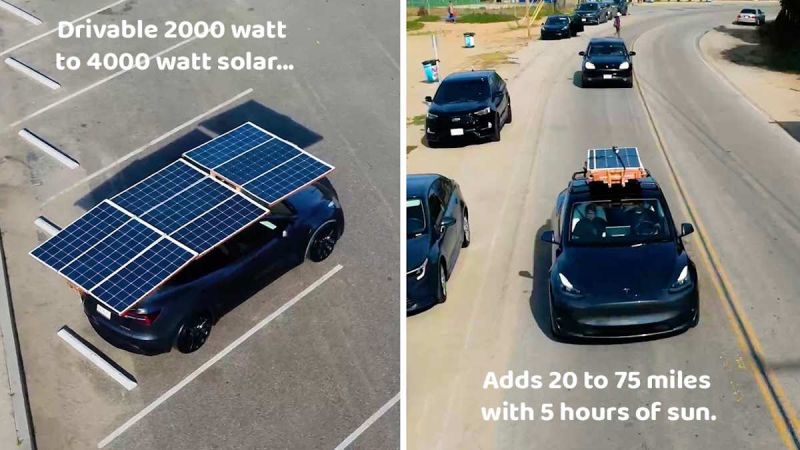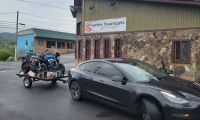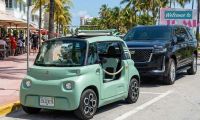Model Y - Solar Array
A Tesla Model Y owner, who goes by the name somid3 on Reddit and DartSolar on YouTube, posted as a longtime reader, sharing his first post about his Tesla Model Y and his custom-built solar array. This is what he had to say:
I've been a long time reader, but not poster. For the last two years I've been working on a 2000 watt to 4000 watt solar system for my Model Y -- Today I can charge anywhere in the world!
I can reliably get 20 miles to 60 miles per day. I can expand these solar panels with ease, and contract them when I want to start driving.
The reason I can pack so many solar panels is because I am using telescoping carbon fiber tubes as my mechanism of expansion and contraction, as opposed to mechanical sliders. This allows me to pack 4000 watts of solar on a Tesla, without going over the max roof weight capacity of 165 lbs.
Overall it has been a fun project so far and I am designing Beta2. Beta1 is 11 inches high and is made out of wood. Beta2 will be fully made of carbon fiber and will be 6 inches high. Right now I researching the DC-to-DC charging and hot wiring.
Having a solar roof affects the Model Y drag coefficient, making it less efficient to air resistance, however, the solar panels more than make up for that.
Elon Musk: "I Am Uncomfortable Growing Tesla To Be a Leader in AI & Robotics Without Having ~25% Voting Control"
Tesla Board, Give Him a New Compensation Package - It's a no-brainer and is only for new growth targets.https://t.co/JGAZcpRmmN
Tesla Board Members:@Tesla IR…— Jeremy Noel Johnson (@AGuyOnlineHere) January 15, 2024
Specs
There are a total of 9 solar panels, each being 175 Watts each. They are designed to be able to sustain the forces of a 440 Watt panel. The whole solar array is a 1.5 kW solar array, with aspirations to become a 4 kW array.
A 1.5 kW solar array should give you about 29 miles on a Tesla Model Y with 5 hours of sun charging DC to DC.
Doing a little math on this and the eventual 4 kW array should give about 77 miles of range - however, DartSolar generally says about 60 miles is the max - likely due to some of the range loss which I'll talk about soon.
I got 77 miles by taking 1,500 Watts and dividing that by 29 miles for what we know of his existing solar array.
Then, I got that value, 51.72, and divided it into 4,000 Watts - which is what the final goal is for the solar array, and that yields about 77 miles and DartSolar reduces that to 60 miles.
Range Loss
There are losses and inefficiencies that happen. There is a 20% manufacturer claim loss, which there is nothing that can be done about. A 20% loss happens in switching between DC to AC and back to DC. And a 20% loss due to aero-dynamic drag due to having the solar panels on the roof of the Model Y.
For the last two losses, these can be solved with time, according to DartSolar. By changing the electronics to DC to DC, the range can be increased.
With the larger solar array, 60 miles per day can be recharged - with less or more depending on sun - and time spent in the sun.
You May Also Be Interested In: Is the Cybertruck Coming To China? Rumor Says Cybertruck Is Coming to China As A Store Display
Design and Mechanics
DartSolar chose this design because he wants sensors and actuators to be able to expand the solar array around the car such that it stays in the parking spot.
However, a 4 kW solar array will go outside the bounds of the car parked in a parking space.
If a pedestrian or cyclist happens to hit the solar panels, they will move inward and absorb some of the hit, minimizing injury to the pedestrian or bicyclist.
Tesla's have a glass roof and can only carry about 175 lbs. of weight on the roof, which includes the roof rack. That weighs about 25 lbs. That leaves 140 lbs. in being conservative for all the solar panels on the roof.
You could use sliders, however, DartSolar uses a telescopy tube, which can expand tenfold if need be. Sliders can only expand about three times their length. Sliders also increase in weight when expanded. Telescopic tubes have been used in fishing poles and ladders, as well as long radio car antennas.
Carbon fiber is the material of choice for the future in his setup. Using strong materials could allow this invention to have around 11 inches in height. The next version will be about 6 to 7 inches in height, which is more efficient in aero-dynamics and drag loss.
Mr. Beast Posts FIRST Video On X - Showing a $100,000 Tesla Model X Plaid Driving Itself and a $100,000,000 Million Carhttps://t.co/52mBrse4jO$TSLA @Tesla @torquenewsauto @MrBeast #cars #evs #gascars #classiccars #flyingcars #boatcars
— Jeremy Noel Johnson (@AGuyOnlineHere) January 16, 2024
DartSolar plans to create a cone and a tail to increase the efficiency of the aero-dynamic drag. Another item to consider is rain, wind, and snow when the car is parked. As the size of the solar panels increases, there needs to be springs that can absorb the pressures of the wind. If the wind is too strong, future versions need to contract the panels to avoid damage.
Modified Solar Panels
Junction boxes help ensure that the solar panels operate at peak efficiency and are generally added to the solar panel themselves. DartSolar removed them so that the solar panels were thinner when placed on top of each other.
All his junction boxes are all in his trunk for his solar panels. This is important because he can change whether the panels are connected in series or in parallel by changing the wiring and configuration in his trunk based on the power unit he has. There's no need to rewire the entire thing based on the capabilities of a new power unit.
This minimizes the need to have thick wires around his solar array. When the solar panels collapse in drive mode, the height is lower due to not having the junction boxes, which are an inch thick each. Had he kept them, the whole thing would have been 3 inches higher.
DartSolar's current version of his solar array is what he calls "Beta 1" and he plans on having future versions of his solar array, "Beta 2" and more.
Another Unique Feature
There are insulated wires of the solar panels. These coiled wires live in the telescopic tubes, which protects them during travel and also uses the empty space in the telescopic tubes. This is simply better engineering and efficient use of space.
Bigger Vehicles
If you can get solar panels and airless tires on an EV, you'll be "doomsday ready" according to DartSolar.
For large vans and buses, as well as an EV ambulance, there needs to be a solution.
The average Watts per mile for a sedan or SUV is 300 Watt-hours per mile. A bus or delivery truck is around 1,000 Watt-hours per mile or 1 kW per mile. The roof of those bigger vehicles is much bigger than a consumer EV.
In the larger vehicle landscape, the solar panels may not even need to expand if DC to DC power is done.
For The Home
There is no product on the market that can automatically charge your EV with DC power from within. If solar panels produce power in DC, it makes sense to transfer that to a battery or capacitor and charge the car directly from within without using an inverter.
Most EVs don't allow you to extract power from your batteries to your home (unless you have a Cybertruck or Rivian, or other truck that allows this). This solar array will allow other vehicles with this solar array to act as solar panels and energy for a home.
Limitations of the Model Y
There are some limitations for the 2022 Model Y that DartSolar has. The rooftop is 67 inches by 47 inches - before not being able to open his trunk or seeing his solar panels from his windshield. He can't have any solar panels larger than that on his roof rack.
For his Beta 2, he will only be able to handle solar panels in those dimensions - or he can add a slider that can slide back the solar array while driving, and have it open up and slide forward when he parks - similar to a driver seat that can move forward and back.
His Beta 1 and Beta 2 versions, as mentioned above, have a 140 lbs. limit. Each of his 175 to 200 Watt solar panels weigh about 7 lbs. For the Beta 2, each 440 Watt solar panel will weigh about 13 lbs. The whole structure needs to weigh about 40 lbs.
That is why DartSolar is using carbon fiber and telescopic tubes to expand the solar array, as well as moving the junction boxes, removing weight.
Beta 2 - the Next Version
Beta 2 is the fifth iteration of this solar array. It will be about 6 inches high as opposed to 11 inches as mentioned earlier. It will hold 350 to 440 Watt solar panels, which will create a solar array of about 4 kW.
If DartSolar can get DC to DC charging figured out, he should be able to add 50 to 60 miles to your car per day - assuming you charge for 5 hours under decent sunlight - parked outside in the sun.
Cost
I asked DartSolar what the cost is on his YouTube video and was told that it is between $2,000 and $4,000 and that they are still putting together the least expensive way to put this together. That's not too bad!
DartSolar is currently working on his Beta 2 version, and this is an exciting development in solar technology for EVs!
In Other Tesla News: Endless Stream of Tesla's Continuously Going Through Boring Tunnel Loop at Las Vegas
What do you think about DartSolar's custom solar panel array for the Model Y? Would you get one?
Share this article with friends and family and on social media - or leave a comment below. You can view my most recent articles here for further reading. I am also on X/Twitter where I post more than just articles daily, as well as LinkedIn! Thank you so much for your support!
Hi! I'm Jeremy Noel Johnson, and I am a Tesla investor and supporter and own a 2022 Model 3 RWD EV and I don't have range anxiety :). I enjoy bringing you breaking Tesla news as well as anything about Tesla or other EV companies I can find, like Aptera. Other interests of mine are AI, Tesla Energy and the Tesla Bot! You can follow me on X.COM or LinkedIn to stay in touch and follow my Tesla and EV news coverage.
Image Credit & Article Reference: Reddit | DartSolar On YouTube











